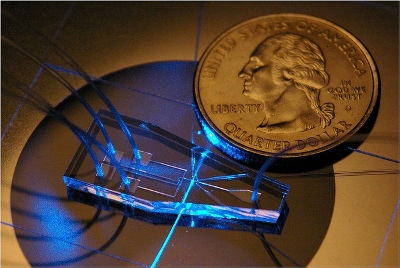Researchers at Penn State led by Associate Professor of Engineering Science and Mechanics, Tony Jun Huang, have devised a chip for three dimensional screening of cell streams for HIV and leukemia diagnosis.
 Flow cytometry chip. (Credit : Tony Jun Huang, Penn State)
Flow cytometry chip. (Credit : Tony Jun Huang, Penn State)
Conventional diagnostic methods employ flow cytometry for counting CD4 cells which form the basis of HIV diagnosis. The current set up is plagued by high costs, bigger size and complexity in mechanical aspects and handling of equipment. The utilization of the flow cytometry technique is thus limited by all these factors. The new device developed by Huang’s team has overcome all these limitations. Theirs is a mass producible device that works on the Microfluidic drifting technology.
Flow cytometry makes use of optical sensors to elicit three types of optical signals from each of the cells in the stream of cells that is illuminated with a laser light. One signal that provides the biochemical characteristics is the result of fluorescence from the antibodies appended to the cell. The second signal is in the form of forward scattering and provides the dimensions of the cell and its refractive index. The third signal is a side scattering that shows cellular granularity. A combined analysis of these signals helps diagnosticians to diagnose and track the state of various diseases such as cancer and HIV. Conventional machines using this technology cost $100, 000 and require elaborate arrangements of multiple lenses and mirrors. The three dimensional flow cell used to streamline the cells is also difficult to manufacture.
Huang’s device however makes use of just a single layer, two-dimensional flow cells and eliminates the need for optical alignment. By using Microfluidic drifting in perpendicular channels, the cells are streamed into a single line and made to pass through a microlaser beam. The fibers for the laser are already available and they are aligned once inserted into the chip without the need for mirrors and lenses. The Microfluidic chip can be produced in bulk using standard lithography techniques. The device is operable by battery and costs about $1000. Initial testing has been done using cell-sized fluorescent beads available in the market. Testing has now begun with real cells.